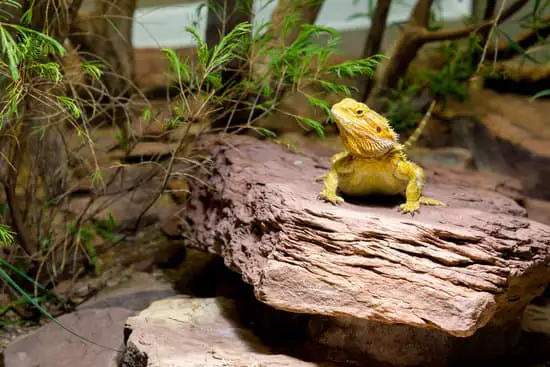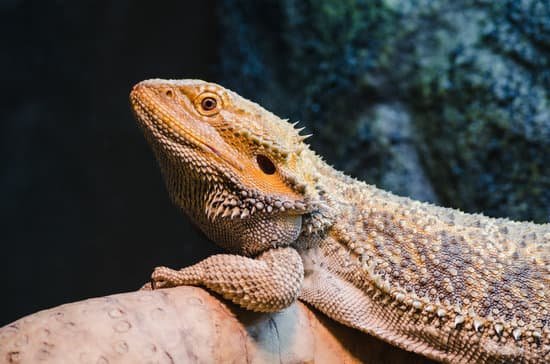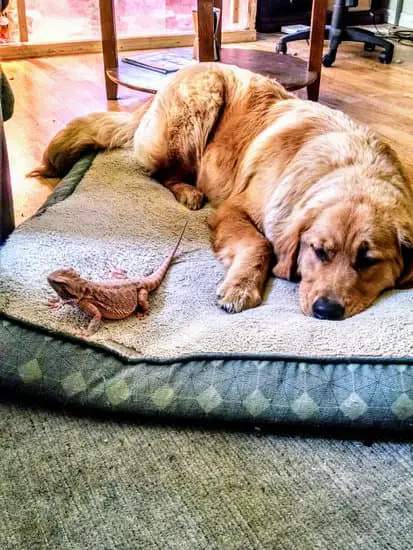Do you have a problem with power at home, and you are wondering what happens when bearded dragons get too cold? Then you are in the right place.
Power may go out unexpectedly, and if you don’t have an alternative way to supply heat, you can’t stop worrying about what might happen to your lizard friend.
I get so many questions from people who get worried that their beardie might be badly affected by the cold temperatures due to power failure or other problems.
But don’t worry, in this article, we’ll know the effects of cold on bearded dragons and more useful information.
This article has been reviewed by Dr. Dilber. Read more about our knowledge control process here.
Contents
Can Bearded Dragons Survive in Cold Temperatures?

One thing you should always remember is that your bearded dragon pet depends on the heat source you supply in the enclosure to warm itself. In general, the beardies are cold-blooded animals; thus, they need to stay in hot areas.
The adequate temperatures for the beardies should be around 90-110℉ depending on the age, but they can safely survive in the low temperature of 65℉.
Although it is possible for the beardies to recover from the temps below 60℉, this condition might pose some health issues.
Moreover, the time that bearded dragons stay in cold temps matters a lot as they can only tolerate slightly cooler temperatures for a period, not more than 24 hours.
Of course, your dragon won’t die immediately due to cold temps, but if the condition persists for more than one day, it affects the digestion process and can cause other problems.
If it is possible, make sure your beardie’s enclosure doesn’t become too cold under any circumstance. If you are traveling with your lizard in the car, be sure to plug the lamp in immediately when you get to your destination.
If there’s no electricity in your vacation area, you should leave the lizard back at home.
What Happens When Bearded Dragons Get Too Cold?

If a beardie stays in the cold for more than 24 hours, most of its standard and daily tasks will be affected, including movement, food digestion, waking up, and bathing. It can also result in diseases like respiratory infection. Some of these problems might become fatal in the end.
Now, let’s cover the side effects of cold to bearded dragons in depth.
Digestion Issues
The most common problem with beardies in cold temps for long is the inability to digest food, and this can affect the overall health. If there is no digestion of food, this means that food remains in the system and eventually rots. This is a fatal situation and can kill your beardie.
This is due to the fact that in low temperatures the metabolic processes of the body slow down. the body uses the energy to normalize the body temperature according to the environment. As a result, there are low calories to proceed with cellular metabolic processes.
Vet answer
Bearded dragons require heat to be able to digest food effectively. They can get the heat by basking in natural sunlight or from the heat lamps provided in the terrarium.
If there is no heat, there’s no digestion and still no absorption of nutrients in the beardie’s body. These lizards cannot generate the heat they require to digest food, and that’s why they depend on the external source.
So, you should ensure that there are correct temperatures in your beardie’s terrarium to prevent any interference with the digestion of food.
Slow Movement
A bearded dragon might become lazy or lethargic when temps are too cold in the habitat. Lack of proper digestion of food makes the beardie lose appetite. This can result in body weakness since the dragon is not getting the essential nutrients the body needs.
Most of the body activities like movement tend to drop, and the lizard spends much time staying in one location and is unresponsive.
I would recommend you to have a thermometer in the basking spot and another one in the cool place to help monitor the temperatures. The basking area temps should be somewhere between 95-110℉ and the cold area 85-90℉.
Not Waking Up
When the temperatures are freezing, bearded dragons may prefer not to wake up but continue sleeping. It is common for beardies to remain in a deep sleep in cold temps, especially during the winter season.
Choosing to continue sleeping due to cold temperatures helps the beardies to avoid the extreme cold, but this does not apply to all bearded dragons. Some dragons do not even brumate during winter.
If you notice your beardie not waking up due to extended periods of cold in the terrarium, and it’s not during winter, you will want to seek help from a reptile vet.
Respiratory Infection
Your beardie could get a respiratory infection when it gets too cold. Maintaining the correct temperatures in the terrarium helps to burn the excess moisture in the air, thus, lowering humidity.
Low temperature increases the humidity in the enclosure and causes inflammation of the mucous membrane. As a result, the respiratory tract gets infected due to the proliferation of bacteria. Besides this, inflamed epithelium cells and cilia of the respiratory tract provide a favorable environment for bacteria and foreign pathogens.
Vet answer
Low temperatures and high humidity will subject the beardie to not only get respiratory infection but also other kinds of health issues and sometimes death.
As such, you will want to make sure that you use a quality hygrometer to monitor the humidity level in the enclosure. Likewise, ensure that the night and day temperatures are correct at all times. The ideal temps at night should be somewhere around 70-75℉.
The right conditions in the habitat, including the right temps, humidity, substrate, spacing, etc., ensure that the beardie is stress-free and lives a long and happy life.
So, anytime you suspect the temps are below average, keep an eye on your dragon and see how it is acting. If you feel that things aren’t right, feel free to see a vet.
Learn the full bearded dragon health issues
How to Keep Your Bearded Dragon Warm When There’s No Power?
In most cases, power failure is the main reason why the beardies find themselves in cold conditions. The electricity can go anytime and may take hours or even days before you get power back.
So, you will need to think of other means practical in warming your bearded dragons. As we have seen in the article, bearded dragons can survive in cold temps only for 24 hours; beyond that time can be risky.
In case of power failure, here are different ways to keep your bearded dragon warm and prevent it from getting cold.
Use a Blanket

should you run out of power supply, you can share your bed with your pet to keep it warm.
You can choose to put your lizard in a pillowcase or blanket and then bring it close to your body. The beardie will absorb your body’s heat, which helps to keep it warm.
If you own a car or can access one, you can consider turning on the heater, wrap your lizard with a blanket and then put it under the heater. It is an excellent way to warm a bearded dragon quickly.
Use of a Box and Styrofoam
Last update on 2022-12-30 / Affiliate links / Images from Amazon Product Advertising API
Another method to keep a bearded dragon warm is using a small box and making sure there is Styrofoam around it. Styrofoam is an excellent insulator, and it prevents heat loss from the box.
Ensure the box has an average of 12 holes and then place a heating pack between the foam. Take your dragon and wrap it in a pillowcase, and then put it in the box. You will also want to ventilate the box more often and place a digital thermometer probe inside the box.
The probe prevents you from opening the box more frequently. You can also use this method when planning to transport your lizard friend.
Rechargeable Heat Bottle or Pack
Another great way to warm a beardie is by use of a rechargeable portable heat bottle or pack. You will want to look for a place where you can charge the bag and then bring it home to heat your lizard’s terrarium.
The pack can stay warm for around eight hours or even more when it is inside the cage. You can also go for hand warmers; they are useful in supplying heat.
Hot Water Bottle
Here, it requires you to heat the water with any means available to you, either by use of charcoal, gas, or gas stove. Then put the hot water in about two or three bottles and place them around the terrarium. The bottles help in distributing heat in the cage.
Hot bottles can be a good alternative to a heat lamp.
Some people say that you can warm bathe your bearded dragons but in my opinion, since you should not bathe your beardies too often, especially when there is no power. Bearded dragon owners bathe their bearded dragons and then right after get them to a heat source.
If you can not ensure you have a good heat source around, don’t try to “warm bathe” them at all.
You can also use a gas generator if you have one, in powering your home when there’s no electricity.
Whichever heat source method you use, be careful not to put the beardie into direct contact with it.
There you have it; there are many methods you can use to warm your pet and protect it from cold. Check the temps in the habitat more often, and in case they go below 65℉, it requires you to act accordingly.
All these tips discussed aren’t for bearded dragons only. They apply to every species of reptile lizards since they are all cold-blooded.
Wrapping Up
Bearded dragons are cold-blooded lizards, and their body cannot generate heat. They use external heat sources like sunlight or basking bulbs to heat their body.
Bearded dragons can survive in cold temps for a while, around 24 hours. If they stay in extreme cold or temperatures below 65℉ for a long time, they can get severe health problems. It is possible for a dragon to die out of the extreme cold.
If you want your beardie to live long and healthy, you will need to maintain proper temperatures and humidity. Also, provide a healthy diet and ensure there’s sufficient spacing.

